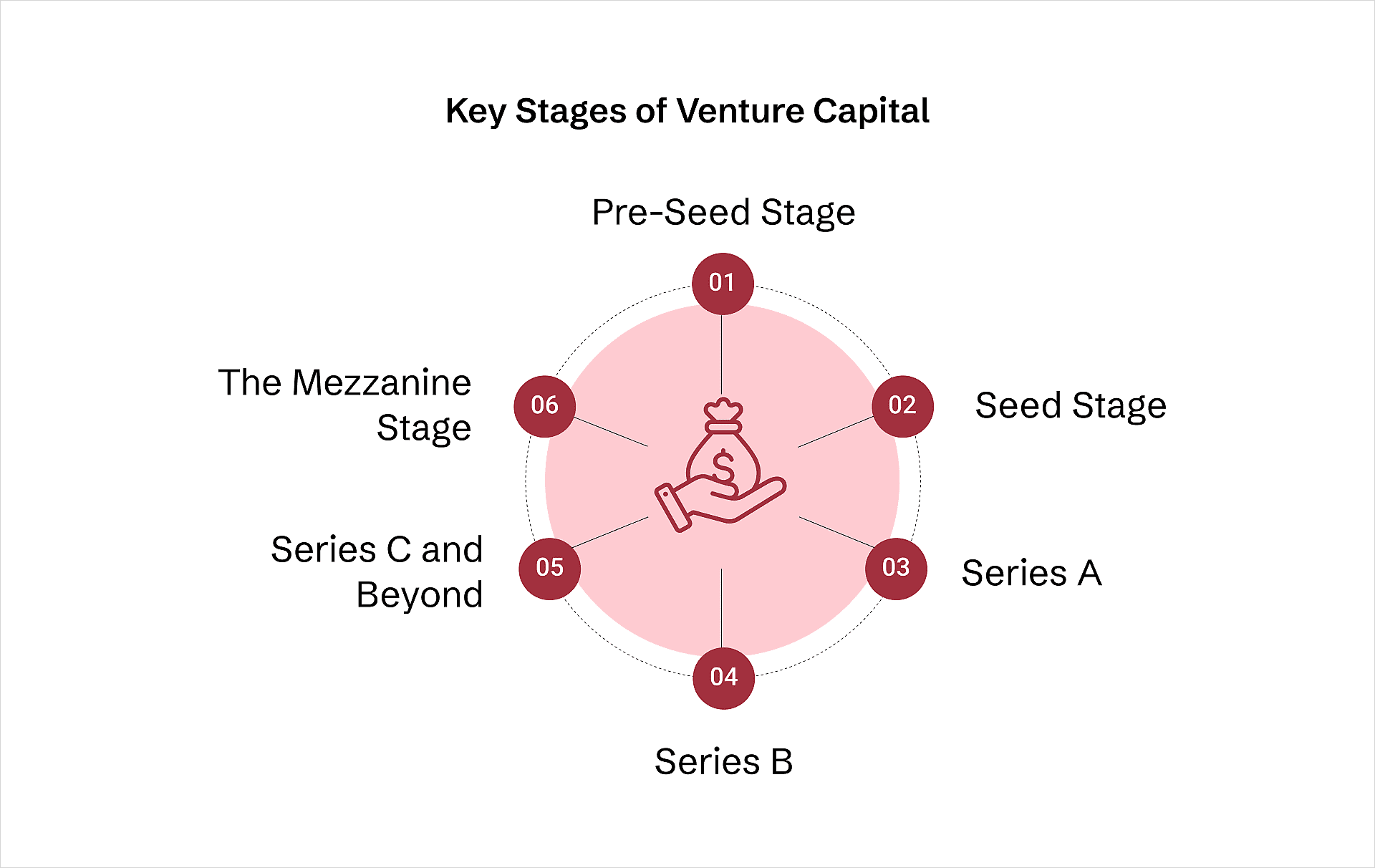
Ideating a new product or solution is easy when compared to launching it as a profitable business. While having a vision is important, making it a reality needs funding.
That’s why partnering with venture capital (VC) firms is a significant part of a startup’s journey and instrumental to its success. In Q4 2022, VC-backed companies raised $32.4 billion, a 14% decrease from Q3 2022.
However, to utilize the power of VC to drive business growth stage venture capital, you must understand the different stages of venture capital and how to secure funding at the right moment.
So read on as we list the several venture capital stages a company goes through and understand how venture capital works.
How Does Venture Capital Work?
Before finding out what are the stages of venture capital, let’s understand what VC firms do.
Venture capital firms support promising entrepreneurs with innovative business ideas that have the potential for success. In exchange for the risk of investing in a new business, they take an equity share in the company. It means that VCs will have a share in the returns when the startup becomes successful. However, if you're looking for alternative funding options, one option to consider is leveraging the best crowdfunding platforms, which allow you to tap into a diverse network of investors and supporters to help bring your startup dreams to life.
In VC funding deals, company ownership is divided into large parts and sold to various investors through limited partnerships (LPs). Venture capital firms execute this collaboration and may have a group of several similar enterprises.
Before investing in a startup, VCs analyze
- The growth potential of the company.
- The strength of the team.
- The uniqueness of their offerings and how they will compete in the market.
Unlike other private equity deals, venture capital invests in emerging companies exploring substantial funding. Private equities focus on more established companies seeking equity infusion.
Venture capital has become a significant source of finance for new companies with an operating history below two years. Although the investors get equity and a say in company decisions, they offer the funding startups cannot access through bank loans and other sources.
You can use the best finance apps to research more about venture capital funding and venture capital funding stages.
Key Stages of Venture Capital

There are five significant stages of venture capital based on the development phase a startup is going through. A pre-seed stage precedes these venture capital stages. Let’s explore these stages of venture capital funding in detail-
Pre-Seed Stage
Technically, this stage comes before accessing venture capital. This is the stage when you are ideating and developing your product with the core team. You assess the potential of your product and check if it fits market needs.
For instance, if your startup is one of the emerging fintech software development companies, you will try a demo installation of your software. It will help you check and resolve any glitches and analyze its viability.
At this stage, you are preparing to pitch to venture capitalists since it's very early for them to invest in exchange for equity. So, most of the funding comes from personal savings, investments from family and friends, angel investors, etc.
Many startups acquire funds through pre-sale revenues and other sources like government grants, tax credits, etc. It allows them to diversify their financial sources and reduce risks before moving to an advanced phase.
This funding is mainly needed to get your operations off the ground and launch your startup.
In the pre-seed stage, you must develop a winning business model and strategize to build a viable company. You can seek advice from fellow founders and entrepreneurs based on their experiences.
Additionally, this is the time to prepare all partnership agreements, legal documents, and tax files and rectify any legal issues. This is essential for acquiring funding, as no one will invest in a business with ongoing legal issues.
Stages of Venture Capital- Seed Stage
This is the first official round of venture capital funding stages. You have gained some experience at the early stage venture capital and can demonstrate your company’s potential. Now, you need a solid pitch showcasing all your milestones and explaining how your idea is profitable.It should also mention the seed capital you need to convince your potential investors more confidently.
It is one of those stages of funding in venture capital when you have entered a more mature phase of your business. Yet, the funding is needed to accelerate your operations with the venture capital funding stages. So, at the seed stage venture capital, the funds you raise will be used for activities like:
- Market research.
- Product development.
- Hiring more team members.
- Development of a business plan.
In these stages of venture capital investment, founders often need to take a more aggressive approach to meet their funding goals. It is essential to demonstrate their capability of scaling the business to current and future investors.
Usually, seed-stage VCs also pitch additional investment rounds concurrently to enhance your credibility. The venture capital firm’s representative joins the board to supervise the operations and ensure all activities happen as planned.
Hence, sometimes, founders hand over large equity shares to the investors to build confidence. Investors at this stage mostly include:
- Startup owner.
- Family and friends.
- Angel investors.
- Early venture capitalists.
Venture Capital Stages- Series A
At the Series A stage, your company has its business plan completed and a solid pitch deck explaining how your product meets market needs. In these venture capital financing stages, you are improving and polishing your product and building a customer base. Your startup is getting closer to growth and revenue generation.
What do you need to do in this phase? Here’s a checklist-
- Fine-tune your product or service.
- Expand your team.
- Conduct more research to support your launch.
- Raise funds to execute your plan and reach out to additional investors.
To analyze your standing at this phase, you must consider factors like-
- A ready-to-use detailed marketing strategy.
- A defined customer acquisition cost.
- Revenue growth rate.
- Net Revenue Return (BRR) rate.
- Overall churn rates.
The last metric is crucial as it demonstrates how many users engage with your product. It also helps show the investors that you can monetize your solution in the long run.
The bulk of the funding at the Series A stage comes from angel investors and traditional venture capitalists. However, startup owners can also explore funding from accelerators and corporate VC funds. These investors are usually interested in startups with a strong business plan and the capability to execute it. It reduces the risk of a failed investment for them.
Stages of Venture Capital Financing- Series B
You acquire a series B status when your company is ready to grow. At this point, you are all set to start the actual manufacturing process, sales, and marketing operations. These tasks require another round of much larger funding from existing and potential investors.
Here, founders must pay attention to metrics like:
- Year-over-year growth.
- Net Revenue Return rate.
- Vertical opportunities.
- Market opportunities.
- Upselling opportunities.
Series B of venture capital process stages starkly differs from Series A of venture capital stages of funding. In the series-A stage, investors analyze your potential for success. In series B, they are focused on observing your actual performance and need evidence of your product’s market viability. It is essential as the performance metrics assure investors of your capabilities to grow on a larger scale.
Typically, family offices specialized in funding established companies, venture capitalists, and corporate venture capitalists provide series B funding. This funding is provided to boost market expansion and create distinct operational teams for marketing, sales, and customer service. You are empowered to meet more customer demands successfully and compete with other market players.
At this point of investment stages venture capital, firms may broker new deals to boost business growth stage venture capital. So, although you may have less control over the trajectory of your business, you will partner with equity stakeholders. They are well experienced in driving success for similar ventures.
Venture Capital Stages- Series C and Beyond
Series C of the stages of venture capital funding occurs when your startup has achieved some success in the market, and you are aiming for expansion with additional funding. You may utilize this funding of the venture capital funding stages for:
- Developing new products.
- Expanding into other markets.
- Acquiring or partnering with other startups.
If your company is growing rapidly, reaching the venture capital funding stages will typically take two to three years. To qualify for this phase of venture capital funding stages, you must have:
- A consistent revenue stream.
- Track record of growth.
- Plans for expansion.
At this point in the venture capital stages of funding, investors are more willing to invest in your startup as you have proven its potential for success. They have lower risk, so the investment looks more attractive and promising.
Common series C investors include-
- Late-stage venture capitalists.
- Private equity firms.
- Hedge funds.
- Banks.
- Corporate venture capital funds.
- Family offices.
Stages of Venture Capital Financing- The Mezzanine Stage
The mezzanine stage, aka bridge stage or pre-public stage, is the last chapter in the venture capital stages. Your startup enters this phase when it is firmly established. You now have a feasible business plan, a successful leadership team, and multiple opportunities in the form of an Initial Public Offering (IPO) or acquisition.
An IPO publicizes your private company by presenting its corporate shares on the open market. This is an effective way for startups and established companies to generate funds and reward initial investors, founders, and teams.
When a company reaches this stage, many investors sell their shares and recover a large profit from their initial investment. It creates opportunities for last-stage investors to enter and gain from an IPO or sale.
Mezzanine financing is a part of borrowed funds and prioritizes between senior debt and equity. As such, it can provide sizeable returns if the company achieves success.
Wrapping Up
The five stages, like early-stage venture capital, more correctly represent a company’s progression from the initial developmental growth stage venture capital for expansion. Understanding these different stages of venture capital can help you secure funding at the right time to avoid a financial crisis.
The pre-seed and seed stage venture capital focuses on developing and polishing your business idea. Series A and Series B of the venture capital stages are meant to grow your company. In comparison, Series C funding aims for business expansion. The last growth stage venture capital maintains expansion or prepare the startup for exit through IPO or acquisition.
Securing funding at each of these stages of funding in venture capital enables you to gain the resources and support to scale your business effectively and achieve success.
Frequently Asked Questions
-
What are the main steps in the venture capital process?
-
What are the types of venture capital?
-
How do VCs acquire funds?




















